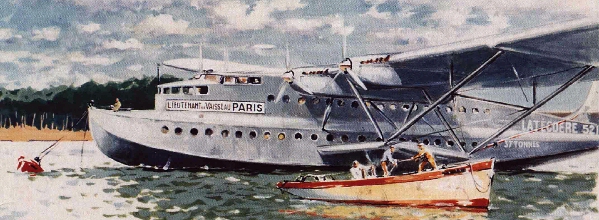

In France, there was the same urge for aircraft with the capability of spanning the oceans, although land planes featured more prominently in operations to the French African possessions, leaving the flying boat for operations to Indo-China and for French ambitions on the Atlantic.
One of the first French designs for a large flying boat to meet a French Air Ministry specification issued in 1928 was the Latecoere 300 series, intended for commercial mail-carrying across the South Atlantic between Dakar and Natal (Brazil). Registered F-AKCU, the sole example made its first flight during 1931, but in December of the same year sank in the Etang de Berre near Marseilles. Early in 1932 it was salvaged, and was then rebuilt, re-registered (as F-AKGF), re-flown (on 7 October 1932) and given the name Croix du Sud. The name was soon to become famous, for on 31 December 1931 piloted by Capitaine de Corvette Bonnot, the flying-boat took off from the lake at Berre to fly non-stop to St Louis (Senegal) in 23 hours 6 minutes - a distance of 2,286 miles (3,679 km).
On 3-4 January it crossed the South Atlantic to Natal, and later that year made a further six crossings while participating in Air France's Dakar-Natal mail service. It continued on these operations during 1935-36 but on 7 December 1936 was lost in mid-ocean while under the command of the celebrated French pilot Jean Mermoz; neither the aircraft nor its crew were ever traced.
Attracted by the
long-range capabilities of the Late 300, the Ministere de
l' Air ordered six examples of a developed version, three
as Latecoere 301 commercial flying-boats for Air France
and three as Latecoere 302 maritime reconnaissance
aircraft for the Aeronavale. These incorporated
modifications made in 1934-35 to the Croix du Sud,
including increases in wing dihedral and vertical tail
area. The Late 301's, like the Late 300, were powered by
four 650 hp Hispano-Suiza 12 Nbr Vee-type engines mounted
back-to-back in tandem pairs above the wing. They were
registered and named (originally) as F-AOIK Orion, F-AOIL
Eridan and F-AOIM Nadir, the first aircraft making its
maiden flight on 7 September 1935. Before entering
service early in 1936, their names were changed to Ville
de Buenos Aires, Ville de Rio de Janeiro and Ville de
Santiago du Chile respectively; F-AOIL, however, was an
early casualty, being lost during a Natal-Dakar flight on
10 February 1936.
 |
Latecoere
302 Moueneyres of Escadrille E4, French Navy
1939. Engines:
4 x 930 hp Hispano-Suiza V12 The Late 302 military version, carrying a crew of eight compared with the four of its commercial counterpart, had more powerful engines, an extended cockpit enclosure reaching to the extreme nose, and the greater wing dihedral and tail area of the earlier machine. The three aircraft were christened Guilbaud, Cavellier de Cuverville |
and Mouneyres, the first of these flying for the first time on 22 February 1936. Initially, a retractable gun turret was mounted in each wing, outboard of the engine nacelle, but these were subsequently removed, the aircraft when in service having two 7.5 mm Darne machine-guns firing laterally from hatches in the hull sides aft of the wings and a third mounted in the bow.
Four 165 lb (75 kg) bombs could be carried on racks attached to the wing bracing struts. Delivery was made to Escadrille E4 at Berre late in 1936. By September 1939 this unit was based at Dakar, and its three 302's were then joined by the Late 301 F-AOIM, which was re-christened de l'Orza.
The last of the Latecoere flying-boats was withdrawn from service with E4 in December 1941.

Painting of the Latecoere 521 "Lieutenant de Vaisseau Paris" - note the twin passenger decks and
forward panoramic salon.
Latecoere aircraft
seemed to be fated, with the Latecoere 521, a 162-foot
wingspan giant monoplane with sponsons and four
Hispano-Suiza engines, flying for the first time in
January, 1935, but being wrecked at its moorings in 1936.
However, after rebuilding, this aircraft set several
payload-to-height records, proving a worthy rival to the
Sikorsky S-42, although the French aircraft was intended
to carry no more than thirty passengers.
| Even more dramatic, the 631, on
which work started in 1937, had its prototype
nearing completion as France fell in May, 1940.
The aircraft was dismantled and hidden in the Forest of Landes, but after liberation in December, 1944, it was reassembled and flew again the following year. Two of these six-engined monoplanes were built, operating on longer overseas services and carrying up to eighty passengers. |
 |
I have been unable to
discover many details on the 521 or the 631 and their
fate - perhaps one of our French visitors will be able to
supply that information.
23 Oct 98